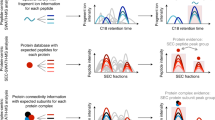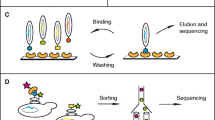Abstract
MELK is an ultrasensitive topological proteomics technology analysing proteins on the single cell level (Multi-Epitope-Ligand-‘Kartographie’). It can trace out large scale protein patterns with subcellular resolution, mapping the topological position of many proteins simultaneously in a cell. Thereby, it addresses higher level order in a proteome, referred to as the toponome, coding cell functions by topologically and timely determined webs of interacting proteins. The resulting cellular protein maps provide new structures in the proteome: single combinatorial protein patterns (s-CPP), and combinatorial protein pattern motifs (CPP-motifs), bound to superior units. They are images of functional protein networks, which are specific signatures of tissues, cell types, cell states and diseases. The technology unravels hierarchies of proteins related to particular cell functions or dysfunctions, thus identifying and prioritising key proteins within cell and tissue protein networks. Interlocking MELK with the drug screening machinery provides new clues related to the selection of target proteins, and functionally relevant hits and drug leads. The present chapter summarizes the steps that have contributed to the establishment of the technology.
Access this chapter
Tax calculation will be finalised at checkout
Purchases are for personal use only
Preview
Unable to display preview. Download preview PDF.
Similar content being viewed by others
References
Schubert W (2000) Automated determining and measuring device and method. US Patent 6 150 173
Schubert W (1992) Antigenic determinants of T lymphocyte α/β receptor and other leukocyte surface proteins as differential markers of skeletal muscle regeneration: detection of spatially and timely restricted patterns by MAM microscopy. Eur J Cell Biol 58:395
Schubert W, Kontozis L, Sticker G, Schwan H, Haraldsen G, Jerusalem F (1988) Immuno-fluorescent evidence for presence of interleukin-1 in normal and diseased human skeletal muscle. Muscle Nerve 11:890
Zimmermann K, Herget T, Salbaum J, Schubert W, Hilbich C, Cramer M, Masters CL, Multhaup G, Kang J, Lemaire HG, Beyreuther K, Starzinski-Powitz A (1988) Localization of the putative precursor of Alzheimer’s disease-specific amyloid at nuclear envelopes of adult human muscle. EMBO J 7:367
Schubert W, Zimmermann K, Cramer M, Starzinski-Powitz A ( 1989) Lymphocyte antigen Leu19 as a molecular marker of regeneration in human skeletal muscle. Proc Natl Acad Sci USA 86:307
Schubert W, Prior R, Weidemann A, Dircksen H, Multhaup G, Masters CL, Beyreuther K (1991) Localization of Alzheimer βA4 amyloid precursor protein at central and peripheral synaptic sites. Brain Res 563:184
Schubert W (1991) Triple immunofluorescence confocal laser scanning microscopy: spatial correlation of novel cellular differentiation markers in human muscle biopsies. Eur J Cell Biol 55:272
Schubert W, Masters CL, Beyreuther K (1993) APP+ T lymphocytes selectively sorted to endomysial tubes in polymyositis displace NCAM-expressing muscle fibers. Eur J Cell Biol62:333
Schubert W, Schwan H (1995) Detection by 4-parameter microscopic imaging and increase of rare mononuclear blood leukocyte types expressing the FcγRIII receptor for immunoglobulin G in human sporadic amyotrophic lateral sclerosis (ALS). Neurosci Lett 198:29
Lendeckel U, Wex T, Ittenson A, Arndt M, Frank K, Maiboroda O, Schubert W, Ansorge S (1997) Rapid mitogen-induced aminopeptidase N surface expression in human T cells is dominated by mechanisms independent of de novo protein biosynthesis. Immunobiology 197:55
Schubert W, Agha-Amiri K, Mayboroda O, Rethfeldt C (1997) Dipeptidyl peptidase IV (CD26) and Alzheimer amyloid protein precursor (APP) in polymyositis. Adv Exp Med Biol 421:273
Kuznetsov AV, Mayboroda O, Kunz D, Winkler K, Schubert W, Kunz WS (1998) Functional imaging of mitochondria in saponin-permeabilized mice skeletal muscle fibers. J Cell Biol 140:1091
Vielhaber S, Kunz D, Winkler K, Wiedemann RF, Kirches E, Feistner H, Heinze HJ, Elger E, Schubert W, Kunz S (2000) Mitochondrial DNA abnormalities in skeletal muscle of patients with amyotrophic lateral sclerosis. Brain 123:1339
Haars R, Schneider A, Bode M, Schubert W (2000) Secretion and differential localization of the proteolytic cleavage products Aβ40 and Ab42 of the Alzheimer amyloid precursor protein in human fetal myogenic cells. Eur J Cell Biol 79:400
Schubert W (2002) Polymositis, topological proteomics technology and paradigm for cell invasion dynamics. J Theoret Med 4:75
Bischoff R (1994) The satellite cell and muscle regeneration. In: Engel AG, Francini-Armstrong C (eds) Myology. McGraw Hill, New York, p 97
De Angelis LD, Berghella L, Coletta M, Lattanzi L, Zanchi M, Gabriella M, Cusella-De Angelis, Ponzetto C, Cossu G (1999) Skeletal myogenic progenitors originating from embryonic dorsal aorta coexpress endothelial and myogenic markers and contribute to muscle growth and regeneration. J Cell Biol 147:869
Schubert W, Friedenberger M, Haars R, Nattkemper T, Ritter H (2002) Automatic recognition of muscle invasive T lymphocytes expressing dipeptidyl-peptidase IV (CD26), and analysis of the associated cell surface phenotypes. J Theoret Med 4:67
Nattkemper T, Ritter H, Schubert W (2001) A neural classifier enabling high-throughput topological analysis of lymphocytes in tissue sections. IEEE Trans Inf Techn Biomed 5:138
Nattkemper T, Ritter H, Schubert W (1999) Extracting patterns of lymphocyte fluorescence from digital microscope images. Intelligent Data Analysis in Medicine and Pharmacology. Proceedings of the annual symposium of the American Medical Informatics Association. Washington, IDAMAP, p 79
Nattkemper TW, Wersing H, Schubert W, Ritter H (2000) A neural network architecture for automatic segmentation of fluorescence micrographs. Proceedings of the European Symposium on Artificial Neural Networks. Bruges, ESANN, p 177
Nattkemper T, Wersing H, Schubert W, Ritter H (2000) Fluorescence micrograph segmentation by Gestalt-Based Feature Binding. Proceedings of the IEEE-INNS-ENNS International Joint Meeting Conference on Artificial Neural Networks. Como, IJCNN
Nattkemper TW, Wersing H, Ritter H, Schubert W (2000) Automatic evaluation of multiparameter fluorescence micrographs with neural network architecture. In: Valafar F (ed) Proceedings of the International Conference on Mathematics and Engineering Techniques in Medicine and Biological Sciences. CSREA press, METMBS, Las Vegas, p 739
Hermann T, Nattkemper TW, Ritter H, Schubert W (2000) Sonification of multi-channel image data. In: Valafar F (ed) Proceedings of the International Conference on Mathematics and Engineering Techniques in Medicine and Biological Sciences. CSREA press, METMBS, Las Vegas, p 745
Mardia KV, Wei Quian, Shah D, de Souza KMA (1997) An algorithm for dividing clusters fluorescent stained nuclei. IEEE Trans Pattern Anal Mach Intell 19:1035
Dow AI, Shafer SA, Kirkwood JM, Mascari RA, Waggoner AS (1996) Automatic multiparameter fluorescence imaging for determining lymphocyte phenotype and activation status in melanoma tissue sections. Cytometry 25:71
Hanahara K, Hiyane M (1990) A circle-detection algorithm simulating wave propagation. Mach Vision Appl 3:97
Galbraith W, Wagner MCE, Chao J, Abaza M, Ernst LA, Nederlof MA, Hartsock RJ, Taylor DL, Waggoner AS (1991) Imaging cytometry by multiparameter fluorescence. Cytometry 12:579
Gerig G, Klein F (1986) Fast contour identification through efficient Hough transform and simplified interpretation strategy. Proc Int Conf Pattern Recognition 8:498
Ballard DH (1981) Generalizing the Hough transform to detect arbitrary shapes. Pattern Recognition 13:111
Author information
Authors and Affiliations
Editor information
Editors and Affiliations
Rights and permissions
Copyright information
© 2003 Springer-Verlag Berlin Heidelberg
About this chapter
Cite this chapter
Schubert, W. (2003). Topological Proteomics, Toponomics, MELK-Technology. In: Hecker, M., et al. Proteomics of Microorganisms. Advances in Biochemical Engineering/Biotechnology, vol 83. Springer, Berlin, Heidelberg. https://doi.org/10.1007/3-540-36459-5_8
Download citation
DOI: https://doi.org/10.1007/3-540-36459-5_8
Received:
Published:
Publisher Name: Springer, Berlin, Heidelberg
Print ISBN: 978-3-540-00546-9
Online ISBN: 978-3-540-36459-7
eBook Packages: Springer Book Archive




